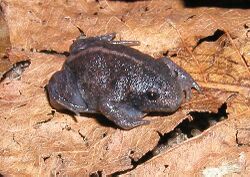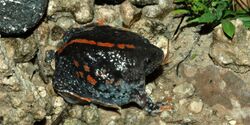Biology:Rhinophrynidae
From HandWiki
Short description: Family of amphibians
| Rhinophrynidae | |
|---|---|

| |
| Juvenile Rhinophrynus dorsalis | |
| Scientific classification | |
| Domain: | Eukaryota |
| Kingdom: | Animalia |
| Phylum: | Chordata |
| Class: | Amphibia |
| Order: | Anura |
| Clade: | Pipoidea |
| Family: | Rhinophrynidae Günther, 1859 |
| Type genus | |
| Rhinophrynus Duméril and Bibron, 1841
| |
The Rhinophrynidae are a family of frogs containing one extant genus, the monotypic Rhinophrynus,[1][2][3][4] and a number of fossil genera.[3][5] The family is sometimes known as the Mexican burrowing toads[1] or simply burrowing toads.[2]
Rhinophrynus occurs in the Central America north from Costa Rica to Mexico and Texas.[1] Fossil finds of Rhinophrynidae come from Mexico, the United States, and Canada.[5] Rhinophrynus is a burrowing ant and termite eater.[2][4]
Systematics
The Rhinophrynidae are the sister taxon of the Pipidae.[1] The clade formed by these two genera is sometimes referred to as Xenoanura[4] or superfamily Pipoidea.[6]
Genera
- Rhinophrynus or Mexican burrowing toad Late Eocene-Recent[7]
- †Chelomophrynus Henrici 1991 Wagon Bed Formation, Wyoming United States, Eocene
- †Eorhinophrynus Hecht 1959 Polecat Bench Formation, Wyoming, United States, Paleocene
- †Rhadinosteus Henrici 1998 Morrison Formation, Utah, United States, Late Jurassic
The affinity of Eorhinophrynus is uncertain.[3]
References
- ↑ 1.0 1.1 1.2 1.3 1.4 Frost, Darrel R. (2016). "Rhinophrynidae Günther, 1859". Amphibian Species of the World: an Online Reference. Version 6.0. American Museum of Natural History. http://research.amnh.org/vz/herpetology/amphibia/Amphibia/Anura/Rhinophrynidae. Retrieved 22 April 2016.
- ↑ 2.0 2.1 2.2 2.3 "Rhinophrynidae". AmphibiaWeb: Information on amphibian biology and conservation. [web application]. Berkeley, California: AmphibiaWeb. 2016. http://www.amphibiaweb.org/lists/Rhinophrynidae.shtml. Retrieved 22 April 2016.
- ↑ 3.0 3.1 3.2 3.3 3.4 Blackburn, D.C.; Wake, D.B. (2011). "Class Amphibia Gray, 1825. In: Zhang, Z.-Q. (Ed.) Animal biodiversity: An outline of higher-level classification and survey of taxonomic richness". Zootaxa 3148: 39–55. doi:10.11646/zootaxa.3148.1.8. http://mapress.com/zootaxa/2011/f/zt03148p055.pdf.
- ↑ 4.0 4.1 4.2 Vitt, Laurie J.; Caldwell, Janalee P. (2014). Herpetology: An Introductory Biology of Amphibians and Reptiles (4th ed.). Academic Press. p. 476.
- ↑ 5.0 5.1 5.2 "Family Rhinophrynidae (burrowing toad)". Paleobiology Database. Fossilworks. http://www.fossilworks.org/cgi-bin/bridge.pl?a=taxonInfo&taxon_no=37442.
- ↑ Ford, Linda S.; Cannatella, David C. (1993). "The major clades of frogs". Herpetological Monographs 7: 94–117. doi:10.2307/1466954.
- ↑ Blackburn, David C.; Roberts, Lauren; Vallejo-Pareja, María C.; Stanley, Edward L. (2019-12-05). "First Record of the Anuran Family Rhinophrynidae from the Oligocene of Eastern North America". Journal of Herpetology 53 (4): 316. doi:10.1670/19-044. ISSN 0022-1511. https://bioone.org/journals/journal-of-herpetology/volume-53/issue-4/19-044/First-Record-of-the-Anuran-Family-Rhinophrynidae-from-the-Oligocene/10.1670/19-044.full.
Wikidata ☰ Q3429460 entry
 |


